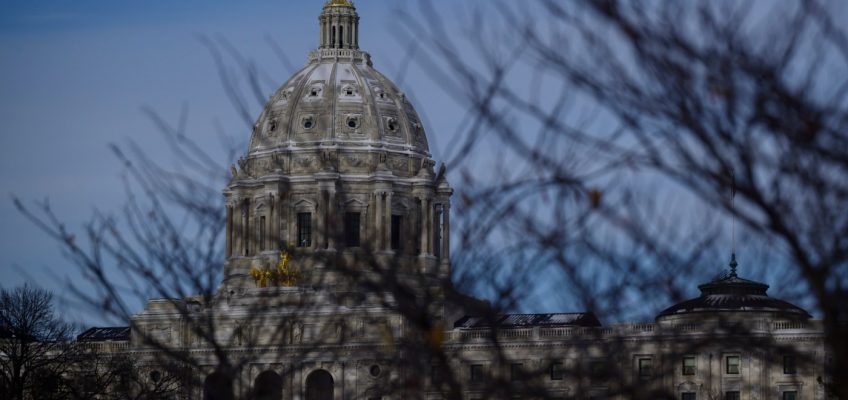In 2025, as we have done for several years now, we feature our readers’ pets at the end of the Morning Report newsletter on weekdays.
This pet corner, typically called the Daily Doggo or the Daily Meow, is a favorite for many of our subscribers.
“I scroll to it every morning to start my day on a positive note!” writes Beth, a regular reader and contributor.
So, to wrap up the year with that positivity, we are sharing some of the more than 260 pet photos (and wildlife!) we received from readers in 2025.
To sign up for the Morning Report, a free newsletter that curates our headlines for you every morning by email, follow the prompts at twincities.com/newsletters. We also encourage readers to sign up for First Edition, an early version of our newsletter, as well as Scoreboard, our new sports newsletter.
A style note: Because we publish only first names of our readers in the pet corner, we continue that tradition here.
January: Staying warm
Doodles was featured in the Morning Report, a Pioneer Press newsletter, on Wednesday, Jan. 22, 2025. (Courtesy of Kathy)
The pet photos in our newsletter document the passing of the seasons here in Minnesota, including this photo of Doodles, one of the 16 cats we featured in the Morning Report in January (along with seven dogs).
“Her favorite spot to stay warm is directly on this heat register,” wrote Kathy of White Bear Lake.
February: Waiting for spring
Sasha was featured in the Morning Report, a Pioneer Press newsletter, on Friday, Feb. 21, 2025. (Courtesy of Cindy)
By February, many of us are growing weary of winter. But houseplants can help brighten our spirits — such as orchids.
“It might be cold outside, but eight-year-old Sasha is thinking spring while enjoying the sun beside the orchids,” Cindy wrote.
The Morning Report pet corner helps chase away the winter doldrums, too, especially in February, when we featured 17 cats and eight dogs in the newsletter.
“I always enjoy the pet photos and stories,” Cindy told us. “They brighten the day.”
March: Waiting for baseball
Charlie, waiting for baseball season, was featured in the Morning Report, a Pioneer Press newsletter, on Thursday, March 6, 2025. (Courtesy of Susan)
In March, as we wrote about 15 cats and seven dogs, we were still waiting … not only for spring, but for baseball season!
Go, Twins!
“This is Charlie, my 3-year-old Springerdoodle, modeling his Christmas present,” wrote Susan. “He is not crazy about wearing clothes but he looks so darn cute wearing his Twins gear!”
April: Holiday photos
Mac, a Golden Retriever, was featured in the Morning Report, a Pioneer Press newsletter, on Monday, April 20, 2025. (Courtesy of Ellen)
As spring begins to bloom, our pets embrace the holidays, or at least willingly pose for spring photos.
“Once again here is our sweet Golden Retriever, Mac, sitting proudly for his Easter pictures!” wrote Ellen. “Hopefully he will find his basket … Happy Easter and happy spring!”
Mac, who makes regular appearances in the Morning Report, was one of 10 dogs, 12 cats and one rabbit we featured in the newsletter in April.
May: Long-distance pets
We featured Scott and Lowla in the Morning Report, a Pioneer Press newsletter, on Friday, May 30, 2025. (Courtesy of Scott)
Not all of our readers live in Minnesota anymore, or year-round. This is how we get to see photos of pets from places ranging from Switzerland to Arizona.
“We recently moved from the Twin Cities to the Tucson, Arizona area,” Scott wrote. “Wasn’t sure how our wire-haired Dachshund, Lowla, would do in the new climate. We just got our golf cart last week and she is absolutely loving riding around in it. Here’s a picture of Lowla living her best life, going for a golf cart ride in her new desert home!”
Of the 14 cats, 12 dogs and one skunk we featured in the Morning Report in May, Lowla was the only desert dog!
June: Memorial Mondays
We featured Ken’s memorial for Tobey in the Morning Report, a Pioneer Press newsletter, on Monday, June 16, 2025. (Courtesy of Ken)
On Memorial Mondays, we remember pets who have passed away. This includes Tobey, one of nine cats and 17 dogs we featured in June.
“With great sadness, my beloved Tobey passed away in my arms on Memorial Day 2025,” wrote Ken, a regular Morning Report contributor.
Ken rescued Tobey when he was in desperate need of a friend.
“Just before his 11th birthday in 2016, his original mom had to be admitted into an assisted living facility and could only take one cat,” Ken explains. “In one fell swoop, Tobey lost his mom, his brother, his house, and everything he knew and was surrendered to the Nevada Humane Society where he was traumatized being alone.”
Despite the hissing, Ken brought Tobey home. It worked out for both of them.
“Tobey was my constant shadow, always wanting to be where I was, and rewarding me with loud purrs and kisses several ties a day as he would climb onto my desk, then into my lap to let me know that he was happy,” Ken says. “He had chosen me as his last person to love and trust for which I will be eternally grateful and always love him.”
July: A beautiful view
Harley, adopted through Twin Cities Rescue at Petco in Highland Park, was featured in the Morning Report, a Pioneer Press newsletter, on Thursday, July 31, 2025. (Courtesy of Shawn)
Summer provides a great window view for the cats of Minnesota, including Harley, one of two cats and five dogs we featured in July’s pet corner.
“Harley, one of our new rescue cats, posed so nicely I thought I’d send it along,” Shawn wrote. “We adopted Harley and his brother Rocket when Kit-Kit, our beloved cat, passed away at age 20. Both Harley and Rocket love perching on high places. This window in the new breakfast nook is a favorite of theirs.”
Shawn told us that Harley and Rocket were adopted through Twin Cities Pet Rescue at Petco on Ford Parkway in Highland Park. See animals available now to adopt or foster and get info on volunteering and more at twincitiespetrescue.org.
August: Vintage pets
Jake was featured in the Morning Report, a Pioneer Press newsletter, on Monday, Aug. 4, 2025. (Courtesy of Wendy)
We started a new feature in the pet corner this year: vintage pets.
Jake was one of 14 dogs and 13 cats we featured in our weekday newsletter in August.
“Our Poodle, Jake, back in the early 1970s (could have been late 1960s),” Wendy wrote. “He loved the car and the camera (I am the youngest child, and I swear there are more pictures of the dog than me). In the car, he could sit on the door frame, with my Dad in the car, waiting for Mom who was shopping. He was a great traveler, asleep in the front seat, with his head on Mom’s lap, until the blinker was on, then he was up and alert.”
September: Puppies!
Louie was featured in the Morning Report, a Pioneer Press newsletter, on Tuesday, Sept. 23, 2025. (Courtesy of Jeannie)
It’s always fun to find readers’ photos of kittens and puppies waiting for us in our inbox. This is how we met Louie, one of the 10 dogs (and 19 cats and one doe) we featured in the newsletter in September.
“I’d like to introduce you to little Louie, the Cavapoo puppy,” Jeannie wrote in August. “Breeds: King Charles Cavalier and Poodle. Weighing in at a wee-but-mighty three pounds, nine ounces. Age: 3.5 months old. Family: Matt, Jeannie and Clay; Dozer (75-pound Black Lab). Foxy (52-pound Australian Cattle Dog mix). Instagram: @ourfriendlouie. Favorite places in town: The Dabbler Depot on West Seventh Street, the patio of Saint Paul Brewing and the patio of Dark Horse in Lowertown.”
October: Wildlife photos
We featured these deer in the Morning Report newsletter on Thursday, Oct. 16, 2025. (Courtesy of Lori)
In addition to pets, we also feature readers’ wildlife photos in the Morning Report.
“Since we can also share our wildlife pictures, here is my Daily Deer photo!” wrote Lori of Columbus, Minn. “Just hanging around enjoying the apples and salt block.”
In addition to the deer, we published photos of nine cats, 15 dogs and two rabbits in the Morning Report in October.
November: Gratitude
Dilly was featured in the Morning Report, a Pioneer Press newsletter, on Thursday, Nov. 27, 2025 — Thanksgiving. (Courtesy of Jack and Suzie)
We are thankful for our pets all year long, but especially in November as Thanksgiving helps us focus on gratitude. In November’s Morning Report, we featured 16 dogs and eight cats, including Dilly.
“This is Dill Pickle aka Dilly,” Jack and Suzie wrote. “She was immediately cuddly at the Humane Society, but we quickly realized that was all a show when she made it to her forever home. She’s a fierce and successful hunter, has more energy than a wall socket (particularly between 3 a.m. to 5 a.m.) and a love to play fetch down a flight of stairs. She has become more cuddly, as the temperatures drop, with a heated blanket. We’re incredibly lucky to have such a smart and playful little one in our lives, she’s given us many laughs and some eyebrow raises already in her short time home.”
December: Waiting for a home
Jazzie and Ringo are waiting for their furr-ever homes through No Kitten Left Behind-MN. (Courtesy of No Kitten Left Behind-MN)
Throughout the year, we feature pets who have been adopted through rescues as well as rescued pets who are still waiting for families. In December, we let readers know that Jazzie and Ringo were still waiting for their furr-ever home.
“Jazzie and Ringo arrived at my home as tiny babies from a cat colony,” wrote Amy, a foster parent with No Kitten Left Behind-MN. “They’ve grown into gorgeous 1-year-old tabbies who add love and laughter to our lives. Ringo is a total snuggle-bug and Jazzie, more cautious, is a little scientist who studies the world around her. They are well-behaved but we also have a blast every evening when it’s time for the thundering zoomies. These sweet kitties are waiting for their own forever home.”
If you want to help bring this bonded pair home this holiday season, search for Jazzie and Ringo on the Petfinder page of No Kitten Left Behind-MN or visit the nonprofit’s Facebook page. at facebook.com/nokittenleftbehind.mn.
Holiday photos
Brian, a Morning Report reader, sent us this holiday photo of Hank, Mila and Bauer that was taken by their mom, Jamie, and featured in our newsletter on Friday, Dec. 19, 2025. (Courtesy of Jamie)
We love receiving holiday photos of readers’ pets, especially when they are all dressed up like Brian and Jamie’s dogs.
“These three are ready for Christmas!” Brian wrote. “Hank is the 2-year-old Labradoodle on the left, Bauer is the 11-month-old Bernadoodle on the right and Mila is the 11-year-old Lab front and center!! Our three boys are grown and out of the house so the puppies replaced them to keep the chaos in the house.”
So happy holidays, readers, and thank you for sharing your pets with us all year long — and for reading our newsletters!
Related Articles
Winter Carnival: Here’s how to nominate your dog for a royal role
Jett once served St. Paul as a police horse; now he’s in need of help
Free pet wellness clinic in St. Paul on Tuesday
Here are the cats and dogs (and skunk!) we featured in the Morning Report in November
New $12M shelter for homeless — and their pets — set to open in Washington County




